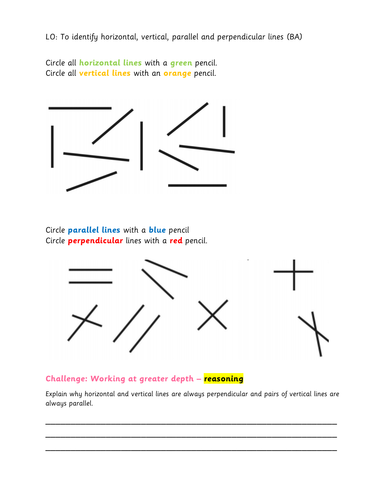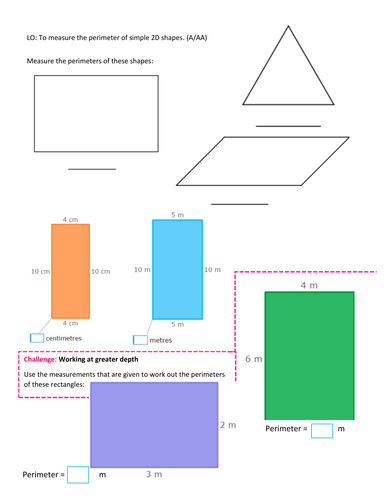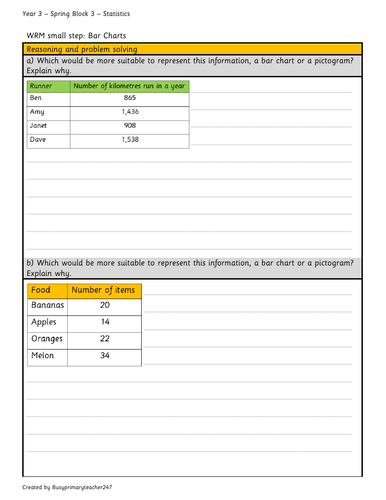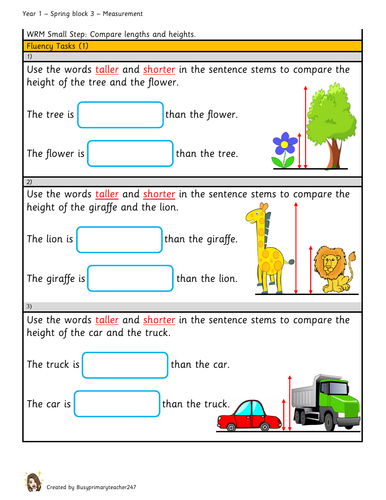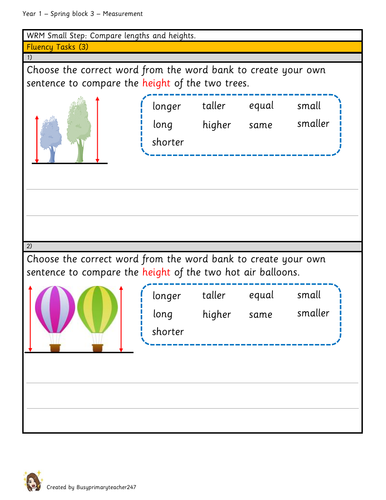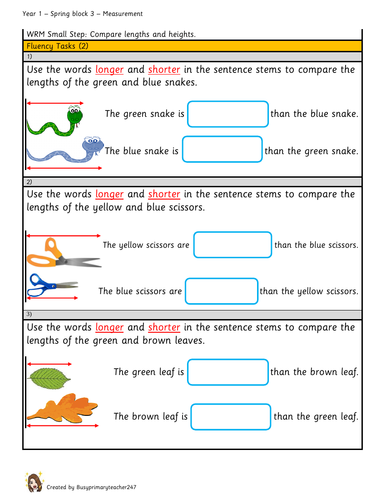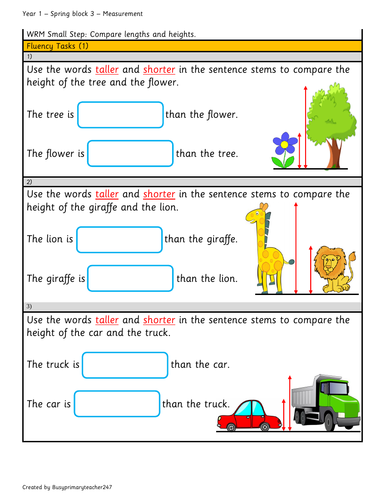120Uploads
186k+Views
67k+Downloads
All resources

Year 3 - Identifying horizontal, vertical, parallel and perpendicular lines
Worksheet / assessment focusing on identifying horizontal, vertical, parallel and perpendicular lines. Differentiated BA and A AA (Includes Greater depth question)
Links with Year 3 National Curriculum and Rising Stars objectives.

Year 3 Question Strips - Addition and Subtraction
This resource includes pictorial and abstract representations to go with fluency, reasoning and problem solving tasks. It compliments weeks 4 - 8 of WRM addition and subtraction unit and contains 25 five-a-day activities to help develop mastery.
Year 3 National Curriculum Objectives covered:
- Add and subtract numbers mentally, including: a three-digit number and ones; a three-digit number and tens; a three digit number and hundreds.
- Add and subtract numbers with up to three digits, using formal written methods of columnar addition and subtraction.
- Estimate the answer to a calculation and use inverse operations to check answers.
- Solve problems, including missing number problems, using number facts, place value, and more complex addition and subtraction.

Year 3 perimeter
Year 3 worksheets / assessment based on measuring the perimeter of simple shapes. Differentiated and includes a greater depth question on A AA sheet.
Links with year 3 National Curriculum and Rising Stars objectives.
Bundle

Year 1 Place Value Bundle (within 50) week 7
This Place Value bundle contains resources linked to Spring, Block 2, place value (within 50) week 7
WRM Small Steps links
Ordering numbers
Count in 2s
Count in 3s
Contents include varied fluency worksheets and reasoning questions that allow children to practise the skills of ordering numbers, counting in 2s and 5s using concrete, pictorial and abstract methods. Also contains answer sheets.
WRM links: Year 1 Spring Block 2, Number, Place Value, Numbers within 50 (week 7)
Curriculum Links
• Count to 50 forwards and backwards, beginning with 0 or 1, or from any number.
• Count, read and write numbers to 50 in numerals.
• Given a number, identify one more or one less.
• Identify and represent numbers using objects and pictorial representations including the number line, and use the language of: equal to, more than, less than (fewer), most, least.
• Count in multiples of twos, fives and tens.
I hope you find this resource useful.
Enjoy x

Year 3 statistics reasoning and problem solving
Reasoning and problem solving questions supporting WRM Small step - Bar Charts.

Year 4 - Fractions - Spring block 3 ( week 7)
This resource includes varied fluency questions that focus on ‘Subtracting two fractions’ and ‘Subtract from whole amounts’. It follows a concrete – pictorial – abstract approach for mastery and also includes reasoning and problem-solving questions. Differentiated two ways and includes answers.
WRM Small Steps
Subtracting two fractions
Subtract from whole amounts
Curriculum links
• Solve problems involving increasingly harder fractions to calculate quantities, and fractions to divide quantities, including non-unit fractions where the answer is a whole number.
• Add and subtract fractions with the same denominator.
I hope you find this resource useful!
Your feedback is always welcome x

Year 1 - Measurement - Comparing Heights
This resource supports Year 1 Measurment - Comparing heights. Children compare heights of a variety of objects using the vocabulary ‘taller’ and ‘shorter’. Answers are included in the
PDF.
Curriculum links
Compare, describe and solve practical problems for: lengths and heights (for example, long/short, longer/shorter, tall/short.
Enjoy x
All images used in this resource are from

Year 1 comparing length and height (Varied fluency 3)
This resource supports WRM Year 1 Spring block 3 Measurement comparing length and height (Fluency task 3).
Children write sentences to compare length and height using key vocabulary - taller, longer, shorter, smaller, bigger, equal, same etc…

Year 1 - Measurement - Comparing lengths (varied fluency 2)
This resource supports Year 1 Measurment - Comparing length and heights. Children compare lengths of a variety of objects using the vocabulary ‘longer’ and ‘shorter’. (Varied fluency 2). Answers are included in the PDF.
Curriculum links
Compare, describe and solve practical problems for: lengths and heights (for example, long/short, longer/shorter, tall/short.
Enjoy x
All images used in this resource are from

Year 1 Measurement comparing length and height (week 8)
These resources suppot WRM Spring block 3 Measurement Small Step: Compare length and height.
Curriculum links
Compare, describe and solve ractical problems for:
lengths and heights (for example, long/short, longer/shorter, tall/short, double/half)

Year 4 – Calculate Fractions of a Quantity – Spring Block 3 - Fractions
This resource includes varied fluency questions focusing on finding fractions of a quantity. It follows a concrete – pictorial – abstract approach for mastery and includes opportunities to use bar modelling. It also includes reasoning and problem solving questions. Differentiated two ways and includes answers.
WRM Small Steps: Calculate fractions of a quantity
National Curriculum Links
• Recognise and show, using diagrams, families of common equivalent fractions.
• Count up and down in hundredths; recognise that hundredths arise when dividing an object by one hundred and dividing tenths by ten.
• Solve problems involving increasingly harder fractions to calculate quantities, and fractions to divide quantities, including non-unit fractions where the answer is a whole number.
• Add and subtract fractions with the same denominator.

Year 4 – Fractions – Calculating Quantities – Spring Block
This resource includes varied fluency questions that focus on calculating fractions of quantities. It follows a concrete – pictorial – abstract approach for mastery and includes opportunities to use bar modeling and concrete materials. It also includes reasoning and problem-solving questions. Differentiated two ways and includes answers.
WRM Small Steps: Calculating Quantities
National Curriculum Links
• Recognise and show, using diagrams, families of common equivalent fractions.
• Count up and down in hundredths; recognise that hundredths arise when dividing an object by one hundred and dividing tenths by ten.
• Solve problems involving increasingly harder fractions to calculate quantities, and fractions to divide quantities, including non-unit fractions where the answer is a whole number.
• Add and subtract fractions with the same denominator.
Your feedback is always welcome x
Bundle

Year 4 Fractions Bundle
This bundle includes everything you need to teach fractions. Each resource follows a concrete – pictorial – abstract approach for mastery and includes opportunities to use number lines, bar models and concrete materials. It also includes varied fluency, reasoning and problem-solving questions. Differentiated two ways and includes answers.
Topics included:
• What is a fraction?
• Equivalent fractions (1)
• Equivalent fractions (2)
• Fractions greater than 1
• Count in fractions
• Add 2 or more fractions
• Subtract 2 fractions
• Subtract from whole amounts
• Calculate fractions of a quantity
• Problem solving – calculate quantities
National Curriculum Links
• Recognise and show, using diagrams, families of common equivalent fractions.
• Count up and down in hundredths; recognise that hundredths arise when dividing an object by one hundred and dividing tenths by ten.
• Solve problems involving increasingly harder fractions to calculate quantities, and fractions to divide quantities, including non-unit fractions where the answer is a whole number.
• Add and subtract fractions with the same denominator.
Your feedback is always welcome x

Year 4 – Fractions – Spring Block 3 (Week 8)
This resource includes varied fluency questions that focus on calculating fractions of quantities. It follows a concrete – pictorial – abstract approach for mastery and includes opportunities to use bar modelling and concrete materials. It also includes reasoning and problem-solving questions. Differentiated two ways and includes answers.
WRM Small Steps:
Calculate fractions of a quantity
Problem Solving - Calculating Quantities
National Curriculum Links
• Recognise and show, using diagrams, families of common equivalent fractions.
• Count up and down in hundredths; recognise that hundredths arise when dividing an object by one hundred and dividing tenths by ten.
• Solve problems involving increasingly harder fractions to calculate quantities, and fractions to divide quantities, including non-unit fractions where the answer is a whole number.
• Add and subtract fractions with the same denominator.
Your feedback is always welcome x

Fractions word wall vocabulary cards
This resource contains 33 fraction based vocabulary cards to be used as flash cards or as part of a display on a working wall. It is appropriate for years 2 - 6.
I hope you enjoy this product!
Your feedback is always welcome x

Fractions - Calculating Quantities - Quiz Card Cooperative Activity
This is a fun and active way to get your class reviewing and consolidating their understanding of calculating quantities. Great as a lesson warm up, end of lesson plenary or test prep. Children work co-operatively with different partners to quiz each other on a variety of questions. If a child gets a question wrong, they give clues and ‘tutor’ them, so that they can both be successful. This product includes 36 quiz cards plus a blank template for children to make their own!
Enjoy!
You freedback is always welcome x
Bundle

Year 3 Multiplication and Division Bundle Autumn term
This year 3 bundle contains 15 question strips related to multiplication and division for the Autumn term. Each strip follows the CPA approach for Maths Mastery and contain varied fluency and reasoning questions.

Year 1 - Place Value - Counting objects
This resource follows the mastery approach to Year 1 place value (concrete - pictorial - abstract) with a main focus on counting objects.
Resources included in this pack:
Power point presentations
Working wall display items
Student worksheets differentiated lower ability, age related, greater depth (plus answers)
Reasoning and problem solving
Curriculum Links:
UK:
Count, read and write numbers to 10 in numerals and words.
Given a number, identify one more or one less.
Identify and represent numbers using objects and pictorial representations including the number line, and use the language of: equal to, more than, less than (fewer), most, least.
Australia:
ACMNA013 - modelling numbers with a range of material and images
ACMNA002 - Connect number names, numerals and quantities, including zero, initially up to 10 and then beyond
ACMNA289 - Compare, order and make correspondences between collections, initially to 20, and explain reasoning
American Common Core Standards
CCSS.MATH.CONTENT.K.CC.A.3
Write numbers from 0 to 20. Represent a number of objects with a written numeral 0-20 (with 0 representing a count of no objects).
CCSS.MATH.CONTENT.K.CC.B.4.A
When counting objects, say the number names in the standard order, pairing each object with one and only one number name and each number name with one and only one object.
CCSS.MATH.CONTENT.K.CC.B.4.C
Understand that each successive number name refers to a quantity that is one larger.

Year 1 - Place Value - One-To-One-Correspondence-To-Start-To-Compare-Groups
This resource follows the mastery approach to Year 1 place value (concrete - pictorial - abstract) with a main focus on one-to-one correspondence of groups 0-10.
Resources included in this pack:
Power point presentation
Working wall display items
Student worksheets differentiated lower ability, age related, greater depth (including answers)
Reasoning and problem solving
Curriculum Links:
UK:
Count, read and write numbers to 10in numerals and words.
Given a number, identify one more or one less.
Identify and represent numbers using objects and pictorial representations including the number line, and use the language of: equal to, more than, less than (fewer), most, least.
Australia:
ACMNA013 - Modelling numbers with a range of material and images
ACMNA002 - Connect number names, numerals and quantities, including zero, initially up to 10 and then beyond
ACMNA289 - Compare, order and make correspondences between collections, initially to 20, and explain reasoning
American Common Core Standards
CCSS.MATH.CONTENT.K.CC.A.3
Write numbers from 0 to 20. Represent a number of objects with a written numeral 0-20 (with 0 representing a count of no objects).
CCSS.MATH.CONTENT.K.CC.B.4.A
When counting objects, say the number names in the standard order, pairing each object with one and only one number name and each number name with one and only one object.
CCSS.MATH.CONTENT.K.CC.B.4.C
Understand that each successive number name refers to a quantity that is one larger.

Year 1-Place Value - Sorting Objects
This resource follows the mastery approach to Year 1 place value (concrete - pictorial - abstract) with a main focus on sorting objects.
Resources included in this pack:
Power point presentations
Working wall display items
Student worksheets differentiated lower ability, age related, greater depth (plus answers)
Reasoning and problem solving
Curriculum Links:
UK:
Count, read and write numbers to 10 in numerals and words.
Given a number, identify one more or one less.
Identify and represent numbers using objects and pictorial representations including the number line, and use the language of: equal to, more than, less than (fewer), most, least.
Australia:
ACMNA013 - modelling numbers with a range of material and images
ACMNA002 - Connect number names, numerals and quantities, including zero, initially up to 10 and then beyond
ACMNA289 - Compare, order and make correspondences between collections, initially to 20, and explain reasoning
American Common Core Standards
CCSS.MATH.CONTENT.K.CC.A.3
Write numbers from 0 to 20. Represent a number of objects with a written numeral 0-20 (with 0 representing a count of no objects).
CCSS.MATH.CONTENT.K.CC.B.4.A
When counting objects, say the number names in the standard order, pairing each object with one and only one number name and each number name with one and only one object.
CCSS.MATH.CONTENT.K.CC.B.4.C
Understand that each successive number name refers to a quantity that is one larger.

